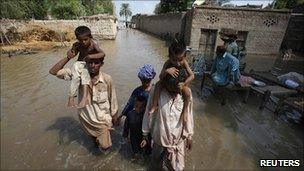President Zardari returns to flood-hit Pakistan
- Published

Nearly 14 million Pakistanis have been affected by the floods
Pakistan's President Asif Ali Zardari has returned to his flood-stricken country, after a foreign tour which has prompted widespread criticism.
Critics were angry he was not at home to oversee the government's response to the disaster, and continued his visit to Europe as the floods worsened.
Mr Zardari is expected to go to some of the affected areas.
But his office said he had been holding meetings since his return and did not plan to visit those areas on Tuesday.
The UN says 1,600 people have been killed and nearly 14 million affected.
As the floods hit Pakistan, Mr Zardari went on a visit to France and the UK, and was criticised back home for being absent when Pakistan was being struck by the worst floods in living memory.
He was already facing criticism for his handling of the economy and of security, says the ±«Óătv's Jill McGivering.
Any perception that during the crisis the army has delivered, and the president proved ineffective, could compound the damage to Pakistan's beleaguered civilian government, she adds.
Enraged survivors have been physically attacking government officials in flood-hit areas, amid widespread anger at the pace of the relief effort.
Mr Zardari's return comes as thousands of people are fleeing Muzaffargarh, a major city of about 250,000 people in Punjab province, central Pakistan, as rivers nearby are swelling and there are warnings of further floods.
The flood wave is also likely to hit the Kotri Barrage near Hyderabad later on Tuesday. With several low lying areas, Hyderabad, Sindh's second largest city after Karachi, is nervous about a huge spillover.
UN special envoy Jean-Maurice Ripert says Pakistan faces its "biggest catastrophe"
Flood waters have roared down from the north to the agricultural heartland of Punjab and on to Sindh along a trail more than 1,000km (600 miles) long.
In the early hours of Monday morning, the water flow coming down the Sukkur Barrage was recorded at up to 1.4m cusecs (cubic feet per second). It is only designed to withstand 900,000 cusecs.
Upper Sindh is already under water, and rescuers are continuing to evacuate people from the province, where the Indus river banks are at risk of bursting. Two million people have already left the area.
±«Óătv Urdu will transmit six daily bulletins in Urdu and Pashto providing vital information including how to stay safe, avoid disease and access aid.